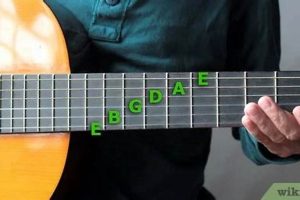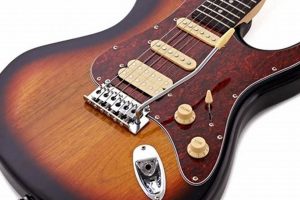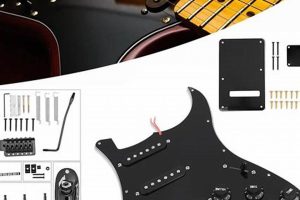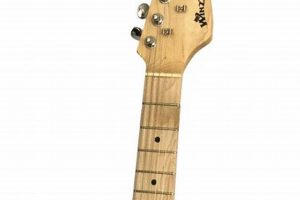Electric guitars are a popular choice for musicians of all levels, but they can be a bit confusing to get started with. One of the most common questions that beginners have is whether or not they need an amplifier. The answer to this question depends on a few factors, including the type of electric guitar you have, the sound you want to achieve, and your budget.
Editor’s Note: Deciding whether or not you need an amp for electric guitar is an important decision. It can affect the sound, feel, and overall experience of playing the guitar.
To help you make the right decision, we’ve put together this guide to everything you need to know about amps for electric guitars. We’ll cover the different types of amps, the pros and cons of each, and how to choose the right amp for your needs.
Key Differences
| Feature | Tube Amps | Solid-State Amps |
|---|---|---|
| Sound | Warmer, more natural sound | Cleaner, more precise sound |
| Price | More expensive | Less expensive |
| Weight | Heavier | Lighter |
| Durability | Less durable | More durable |
Main Article Topics
- The different types of amps for electric guitars
- The pros and cons of each type of amp
- How to choose the right amp for your needs
- Tips for getting the most out of your amp
1. Tone
When it comes to electric guitars, tone is everything. And while the guitar itself plays a big role in determining your sound, your amp is just as important. Amps allow you to shape the tone of your guitar, from clean and bright to warm and overdriven. This gives you a huge range of sonic possibilities to explore.
- Clean Tone: A clean tone is the natural sound of your guitar, with no distortion or effects added. This is a great sound for playing country, jazz, and other styles of music that require a clear and articulate sound.
- Bright Tone: A bright tone is a clean tone with a bit of extra treble boost. This can help your guitar cut through the mix in a band setting, and it’s also a good sound for playing funk and other styles of music that require a bright and sparkly sound.
- Warm Tone: A warm tone is a clean tone with a bit of extra bass boost. This can give your guitar a more mellow and full sound, and it’s a good sound for playing blues, rock, and other styles of music that require a warm and rich sound.
- Overdriven Tone: An overdriven tone is a distorted tone that is created when the amp’s input signal is pushed too hard. This can create a wide range of sounds, from a slight crunch to a full-on distortion. Overdriven tones are often used for playing rock, metal, and other styles of music that require a distorted sound.
The type of amp you choose will have a big impact on your tone. Tube amps are known for their warm and natural sound, while solid-state amps are known for their clean and precise sound. Hybrid amps combine the best of both worlds, offering a warm and natural sound with the clean and precise sound of a solid-state amp. Ultimately, the best way to find the right amp for your sound is to try out different amps and see what you like best.
2. Volume
The volume of an electric guitar is one of the most important factors to consider when deciding whether or not to use an amp. Electric guitars are much quieter than acoustic guitars, so if you want to be heard over other instruments or in a large space, you’ll need an amp.
- Playing in a band: If you’re playing in a band, you’ll need an amp to be able to hear yourself over the other instruments. Even if you’re just practicing with a drummer, you’ll need an amp to be able to hear your guitar clearly.
- Playing in a large space: If you’re playing in a large space, such as a concert hall or outdoor festival, you’ll need an amp to be able to project your sound to the audience. Even if you’re playing in a smaller space, such as a club or coffee shop, an amp can help you to fill out the sound and make your guitar more audible.
- Playing with effects: If you’re using effects pedals, such as distortion, reverb, or delay, you’ll need an amp to power them. Effects pedals can’t be used without an amp, so if you want to use effects, you’ll need to get an amp.
- Recording: If you’re recording your guitar playing, you’ll need an amp to get a good sound. Recording an electric guitar without an amp will result in a thin and weak sound.
Ultimately, the decision of whether or not to use an amp for electric guitar is a personal one. However, if you want to be heard over other instruments or in a large space, or if you want to use effects pedals or record your guitar playing, then you’ll need an amp.
3. Effects
Many guitarists use effects pedals to add effects to their sound, such as reverb, delay, and distortion. These effects can add depth, space, and texture to your sound, and they can also be used to create a wide range of different tones. However, effects pedals require an amplifier to power them. This means that if you want to use effects pedals with your electric guitar, you will need an amp.
- Reverb: Reverb is an effect that simulates the natural reverberation of a room or space. This can add depth and space to your sound, and it can also be used to create a sense of atmosphere. Reverb is a popular effect for a wide range of genres, from rock to jazz to country.
- Delay: Delay is an effect that repeats your guitar signal back to you after a set amount of time. This can create a variety of different effects, from a subtle echo to a long, spacious delay. Delay is a popular effect for rock, pop, and electronic music.
- Distortion: Distortion is an effect that adds a crunchy, overdriven sound to your guitar. This can be used to create a wide range of different tones, from a slight overdrive to a full-on distortion. Distortion is a popular effect for rock, metal, and blues.
These are just a few of the many different effects that can be used with an electric guitar. With an amp, you can explore a wide range of different sounds and create your own unique tone.
4. Practice
Using an amp for practice offers significant benefits for electric guitarists, making it an essential tool for improving skills and achieving desired musical outcomes. Here’s how practicing with an amp contributes to the development of guitar playing:
- Accurate Monitoring: An amp provides an amplified and accurate representation of your playing, allowing you to hear the nuances of your technique clearly. This enables you to identify areas for improvement, such as timing, note clarity, and dynamics.
- Enhanced Feedback: Playing through an amp provides immediate feedback on your playing, helping you develop a better understanding of how different techniques affect the sound. This feedback loop accelerates your learning process and allows you to refine your approach.
- Volume Control and Projection: An amp gives you control over the volume of your guitar, enabling you to practice at appropriate levels for your environment. Additionally, it allows you to project your sound, making it easier to hear yourself when practicing with other musicians or in larger spaces.
- Effect Exploration: Many amps feature built-in effects, such as distortion, reverb, and delay. Practicing with these effects can help you experiment with different sounds and develop your own unique style. It also allows you to explore the impact of effects on your playing technique.
In summary, practicing with an amp is crucial for electric guitarists who want to improve their skills, monitor their progress accurately, and explore the full range of possibilities that the instrument offers. It provides a valuable tool for developing technique, enhancing feedback, controlling volume, and experimenting with effects, ultimately contributing to the guitarist’s musical growth and enjoyment.
5. Recording
Recording your electric guitar playing is a great way to capture your ideas, share your music with others, and collaborate with other musicians. However, in order to record your guitar, you will need an amplifier.
- Direct Input vs. Microphone: There are two main ways to record an electric guitar: direct input (DI) and microphone. DI involves plugging your guitar directly into an audio interface, while microphone involves placing a microphone in front of your amp. Both methods have their own advantages and disadvantages, but in general, DI is better for recording clean guitar sounds, while microphone is better for recording overdriven or distorted guitar sounds.
- Amp Emulation: If you don’t have an amp, or if you want to experiment with different amp sounds, you can use amp emulation software or pedals. Amp emulation simulates the sound of a real amp, and it can be a great way to get a great guitar sound without having to buy an expensive amp.
- Home Recording: If you’re just starting out, you can record your guitar at home using a simple setup. All you need is an audio interface, a recording software, and an amp or amp emulation. Once you have your setup, you can start recording your guitar playing and sharing your music with the world.
- Studio Recording: If you’re serious about recording your guitar, you may want to consider recording in a professional recording studio. Studios have the equipment and expertise to help you get the best possible sound quality for your recordings.
Whether you’re just starting out or you’re a seasoned pro, recording your electric guitar playing is a great way to capture your ideas, share your music with others, and collaborate with other musicians. With the right equipment and a little bit of know-how, you can get great results recording your guitar at home or in a studio.
6. Performance
When it comes to playing electric guitar live, an amplifier is an absolute necessity. Without an amp, your guitar’s signal will be too weak to be heard over the other instruments on stage. This means that you won’t be able to project your sound to the audience, and your performance will suffer as a result.
Amps allow you to control the volume of your guitar, so you can make sure that you’re heard over the other instruments on stage. They also allow you to shape your tone, so you can create the sound that you want. Whether you’re playing clean, overdriven, or distorted, an amp will help you to achieve the sound that you’re looking for.
In addition to volume and tone, amps also provide effects such as reverb, delay, and chorus. These effects can add depth and dimension to your sound, and they can help you to create a unique and personal style.
If you’re serious about playing electric guitar live, then you need an amp. Amps are essential for projecting your sound to the audience, and they give you the control and flexibility you need to create the sound that you want.
Here are some real-life examples of how amps are used in live performances:
- Jimmy Page used a Marshall stack to create the iconic sound of Led Zeppelin.
- Eric Clapton used a Fender Twin Reverb to achieve his signature clean tone.
- Eddie Van Halen used a Peavey 5150 to create his own unique and innovative sound.
These are just a few examples of how amps are used to create great guitar sounds in live performances. If you’re serious about playing electric guitar live, then you need to get an amp. Amps are essential for projecting your sound to the audience, and they give you the control and flexibility you need to create the sound that you want.
7. Versatility
The versatility of amps is a key factor to consider when deciding whether or not you need an amp for electric guitar. Amps can be used with a variety of guitars and other instruments, making them a versatile piece of gear that can be used for a wide range of musical applications.
For example, amps can be used with electric guitars, acoustic guitars, bass guitars, and even keyboards. This makes them a great choice for musicians who play multiple instruments or who want to be able to use their amp for a variety of purposes.
In addition to being used with a variety of guitars, amps can also be used with other instruments such as microphones, keyboards, and drum machines. This makes them a great choice for musicians who want to be able to use their amp for a variety of musical applications, such as playing solo, playing in a band, or recording music.
The versatility of amps makes them a great choice for musicians of all levels and genres. Whether you’re just starting out or you’re a seasoned pro, an amp can help you to get the sound you want and achieve your musical goals.
Here are some real-life examples of how amps are used with a variety of guitars and other instruments:
- Keith Richards of the Rolling Stones uses a Fender Twin Reverb amp to get his signature clean sound.
- Eric Clapton uses a Marshall stack to get his signature bluesy tone.
- Ed Sheeran uses a Boss Katana amp to get his signature acoustic sound.
- Trent Reznor of Nine Inch Nails uses a variety of amps to get his signature industrial sound.
These are just a few examples of
how amps can be used with a variety of guitars and other instruments to create a wide range of sounds. If you’re looking for a versatile piece of gear that can be used for a variety of musical applications, then an amp is a great choice.
8. Portability
When it comes to choosing an amp for electric guitar, portability is an important consideration. If you’re going to be gigging or traveling with your amp, you’ll want one that’s easy to transport. Fortunately, amps come in a variety of sizes and weights, so you can find one that fits your needs.
- Size: Amps come in a variety of sizes, from small and portable to large and heavy. If you’re going to be gigging or traveling with your amp, you’ll want to choose one that’s small and lightweight enough to be easy to transport.
- Weight: Amps also come in a variety of weights, from a few pounds to over 100 pounds. If you’re going to be gigging or traveling with your amp, you’ll want to choose one that’s light enough to be easy to carry.
In addition to size and weight, there are a few other factors to consider when choosing a portable amp for electric guitar. These factors include:
- Power: The power of an amp is measured in watts. The more watts an amp has, the louder it will be. If you’re going to be playing in a large venue, you’ll need an amp with more power.
- Features: Amps come with a variety of features, such as reverb, delay, and distortion. If you’re looking for an amp with a specific set of features, be sure to do your research before you buy.
Once you’ve considered all of these factors, you can start shopping for a portable amp for electric guitar. There are a number of great amps on the market, so you’re sure to find one that meets your needs.
9. Affordability
The affordability of amps is a key factor to consider when deciding whether or not you need an amp for electric guitar. Amps range in price from a few hundred dollars to over a thousand dollars. This means that there is an amp to fit every budget.
If you’re just starting out, you may not want to spend a lot of money on an amp. There are a number of affordable amps on the market that are perfect for beginners. These amps typically have fewer features and less power than more expensive amps, but they are still capable of producing great sound.
As you progress on your guitar journey, you may decide that you want to upgrade to a more expensive amp. More expensive amps typically have more features and more power, which can give you more control over your sound. However, it’s important to remember that the most expensive amp is not always the best amp. The best amp for you is the one that fits your needs and budget.
Here are some real-life examples of how affordability affects the decision of whether or not to buy an amp for electric guitar:
- A beginner guitarist may choose to buy a less expensive amp because they are not sure how committed they are to playing guitar. They need an amp to make sound from the guitar so they go for a budget friendly option.
- A professional guitarist may choose to buy a more expensive amp because they need more features and power to get the sound they want. Their livelihood depends on having a quality sounding guitar sound through an amp.
Ultimately, the decision of whether or not to buy an amp for electric guitar is a personal one. However, by considering the affordability of amps, you can make an informed decision that is right for you.
| Price Range | Type of Guitarist | Recommended Amp |
|---|---|---|
| Under $500 | Beginner | Fender Squier Frontman 10G |
| $500-$1000 | Intermediate | Marshall MG10CF |
| Over $1000 | Professional | Mesa/Boogie Mark V |
FAQs
Electric guitars are a popular choice for musicians of all levels, but they can be a bit confusing to get started with. One of the most common questions that beginners have is whether or not they need an amplifier. This FAQ section addresses common concerns or misconceptions regarding the use of amps for electric guitars.
Question 1: Do I really need an amp to play the electric guitar?
Answer: Yes, an amplifier is essential for playing the electric guitar. While it is possible to play an electric guitar without an amp, the sound will be very quiet and distorted.
Question 2: What are the benefits of using an amp with an electric guitar?
Answer: Amplifiers provide several benefits for electric guitarists, including increased volume, improved sound quality, the ability to add effects, and the option to use headphones for silent practice.
Question 3: How do I choose the right amp for my electric guitar?
Answer: The choice of amp depends on factors such as the type of electric guitar, desired sound, volume requirements, features, and budget. Consider the power output, speaker size, tone controls, and effects when selecting an amplifier.
Question 4: Can I use an amp with other instruments besides the electric guitar?
Answer: Yes, many amps are designed to be used with various instruments, including acoustic guitars, bass guitars, keyboards, and microphones.
Question 5: How do I maintain my amp to ensure optimal performance?
Answer: Regular maintenance is crucial for the longevity and performance of an amp. This includes cleaning the amp, replacing tubes or transistors when necessary, and avoiding overloading the amp to prevent damage.
Question 6: What are some tips for getting the best sound from my amp?
Answer: Experiment with different amp settings, such as gain, volume, and tone controls, to find the optimal sound that complements the electric guitar and playing style. Additionally, consider using pedals or effects processors to enhance and shape the sound further.
Summary: Amplifiers play a vital role in the electric guitar experience, providing volume, sound enhancement, and versatility. Choosing the right amp and maintaining it properly are essential for achieving the desired sound and maximizing the potential of the electric guitar.
Transition to the next article section: For further exploration, let’s delve into the different types of amps available and their respective characteristics, helping you make an informed decision when selecting an amplifier for your electric guitar.
Tips for Using an Amp with Electric Guitar
Using an amplifier with an electric guitar unlocks a world of possibilities for musicians. Here are some essential tips to help you get the most out of your amp and electric guitar:
Tip 1: Start with the Basics
Begin by understanding the fundamental controls on your amp. The gain knob controls the amount of distortion, while the volume knob adjusts the overall loudness. Experiment with these settings to find a balance that suits your playing style and the desired sound.
Tip 2: Explore the Equalizer (EQ)
Most amps have an EQ section that allows you to adjust the frequency response of your sound. Use the bass, mid, and treble knobs to shape your tone. Boosting the bass can add warmth, while increasing the treble can enhance clarity.
Tip 3: Use Effects Sparingly
Effects pedals can add depth and interest to your sound. However, it’s important to use them sparingly to avoid overwhelming your tone. Start with a single effect, such as reverb or delay, and gradually add more as needed.
Tip 4: Consider Speaker Size and Type
The size and type of speaker in your amp can significantly impact your sound. Larger speakers generally produce a fuller, warmer tone, while smaller speakers are more suited for brighter, cleaner sounds. Consider the musical style you play and choose a speaker that complements it.
Tip 5: Match Impedance
Impedance matching is crucial to ensure proper power transfer between your amp and speaker. Mismatched impedance can lead to reduced volume, distorted sound, or even damage to your equipment. Always check the impedance rating of your amp and speaker to ensure they match.
Tip 6: Position Your Amp Wisely
The placement of your amp can affect the sound you hear. Experiment with different positions in the room to find the sweet spot where the sound is evenly distributed and balanced.
Tip 7: Practice Regularly
Regular practice is essential to develop your skills and master the nuances of playing through an amp. Experiment with different settings and techniques to discover the full potential of your amp and electric guitar combination.
By following these tips, you can harness the power of your amp and electric guitar to create a sound that is uniquely yours. Embrace the versatility and explore the endless possibilities that this dynamic duo offers.
Conclusion
The decision of whether or not to use an amplifier for electric guitar is a crucial one that can significantly impact your playing experience and sound. Throughout this article, we have explored the various reasons why an amp is essential for electric guitarists, including volume amplification, tone shaping, effects utilization, practice enhancement, recording capabilities, live performance necessity, versatility with different instruments, portability options, and affordability considerations.
Whether you are a beginner or an experienced guitarist, understanding the benefits and uses of an amp will empower you to make an informed decision that aligns with your musical goals and playing style. Embrace the power of amplification and unlock the full potential of your electric guitar. By selecting the right amp and utilizing it effectively, you can elevate your playing, inspire your creativity, and share your music with the world.







